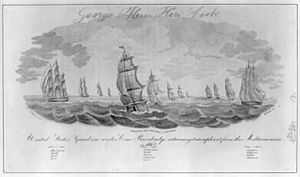USS Spitfire (1814) facts for kids
Quick facts for kids History |
|
|---|---|
| Name | USS Spitfire |
| Builder | Kemp |
| Launched | 1812 |
| Acquired | by the Navy between October and December 1814 |
| In service | circa 20 May 1815 |
| Out of service | circa 1816 |
| Fate | Sold 3 April 1816; fate unknown |
| General characteristics | |
| Type | schooner |
| Tons burthen | 286 (bm) |
| Length | 106 ft (32 m) (between perpendiculars) |
| Beam | 25 ft 6 in (7.77 m) |
| Draft | 11 ft 8 in (3.56 m) |
| Sail plan | Schooner |
| Complement |
|
| Armament |
|
The USS Spitfire was a fast sailing ship, originally named Grampus. The United States Navy bought her to help fight in wars. She was a type of ship called a schooner, which means she had two or more masts and sails. The Spitfire was built to be strong and carry many weapons. She was ready for the War of 1812, but her main job came later in the Barbary Wars. She sailed to the Mediterranean Sea with other American ships. Their mission was to stop pirates from attacking American trading vessels.
Spitfire as a Privateer
Before becoming a Navy ship, Spitfire was known as Grampus. She was a "privateer," which was a private ship allowed by the government to attack enemy ships during wartime. Her captain was John Murphy. She officially became a privateer on February 12, 1813.
As a privateer, Grampus was very successful. She captured or recaptured eight different ships:
- Catherine & William, a brig (a type of two-masted ship), was lost at sea.
- Eclipse, another brig, was sent to port.
- Ceres, a brig, was burned.
- Expedition, a ketch (a small two-masted boat), was sent to New York.
- Doris, a brig used for transport, was sent to Marblehead.
- Speculator, a brig, was given back to its owners.
- Dry Harbor, a schooner, was sent to port.
- Another brig was burned.
The Spitfire was the third ship to have this name in the U.S. Navy. The Navy bought her in Baltimore, Maryland, around December 21, 1814. The plan was for her to join a group of ships led by Commodore David Porter. This group was supposed to attack British ships in the West Indies.
However, the Treaty of Ghent was signed, ending the War of 1812 between America and the United Kingdom. This happened before Commodore Porter's ships could even leave port.
Fighting in the Barbary Wars

Even though the war with the UK was over, the United States was starting new problems with Algiers. So, the ships that were meant for Porter's group were instead sent to fight the Barbary pirates. This new fleet was led by Commodore Stephen Decatur.
The Spitfire left New York City with this fleet on May 20, 1815. They sailed all the way to the Mediterranean Sea. On June 19, the Spitfire helped other American ships, including the Epervier, Spark, and Torch. They chased an Algerian brig called Estedio onto the shore near Cape Palos and captured it.
After this, the Spitfire sailed with the fleet to Algiers. Their strong presence there forced the ruler, called the Dey, to agree to America's demands.
The fleet then sailed to Tunis and Tripoli. In both places, they successfully demanded payments for past problems. These payments were for breaking agreements with the United States during the recent war with the UK.
In September, the Spitfire headed back home. She was kept out of service until she was sold on April 3, 1816. Her exact fate after being sold is not known.

